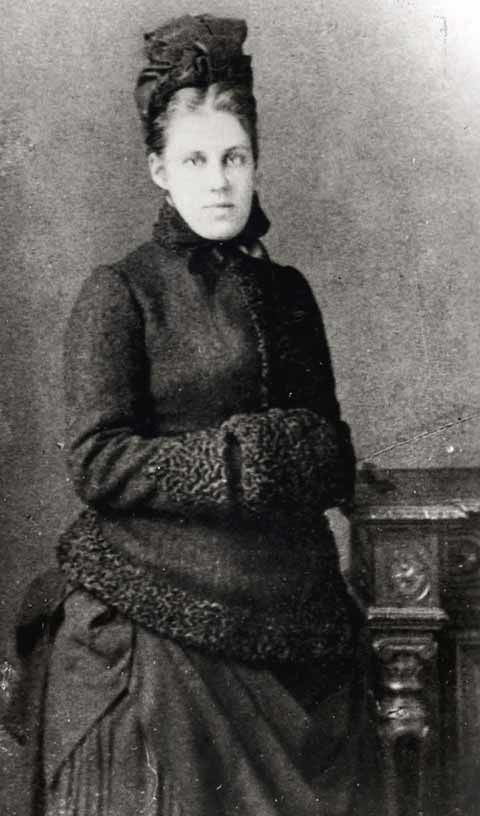Emma Lazarus and the Poem on Lady Liberty’s Pedestal
One of the most beloved features of the Statue of Liberty is the poem inscribed on a bronze plaque inside its pedestal. “Give me your tired, your poor/Your huddled masses yearning to breathe free,” which appear in the middle of the work, have come to define what the statue has represented for generations. Those words are from “The New Colossus,” a poem written by Greenwich Village resident Emma Lazarus on November 2, 1883. But it took another two decades for her words to become so closely associated with the statue in the harbor and shape its identity as a symbol of hope to millions.

Lazarus wrote the poem from her home at 18 West 10th Street, an Italianate-style structure built in 1856 that her family moved into earlier in 1883. Descendants of America’s first Jewish settlers, Moses and Esther Lazarus along with their seven children had a long history living in Greenwich Village, including an earlier home at long-demolished 36 West 14th Street. Emma, the fourth child in this wealthy Sephardic family, was born on July 22, 1849.
Lazarus was educated at home, gaining a knowledge of Greek and Latin classics, as well as modern German, Italian, and French literature. She wrote her first poems at the age of 11, and as a teen translated the poetry of Victor Hugo, Heinrich Heine, Alexandre Dumas, and Friedrich Schiller. Her father arranged for a private publication of her earliest works in 1866, and a year later they were printed by commercial publisher Hurd and Houghton in Poem and Translations. At the age of 19, the precocious author sent a copy of the latter work to Ralph Waldo Emerson, who became a mentor over the next few years by offering both ardent praise and incisive criticism of her poetry. The main poem in her 1871 book Admetus and Other Poems was dedicated to Emerson.

Her first and only novel Alide: An Episode in Goethe’s Life appeared in 1874, and her poetry and essays were published in several collections and in magazines including Scribner’s Monthly and The Century. As she continued her writing, she became more focused on combating anti-semitism in the United States and Europe, as well as helping immigrants. Lazarus proclaimed herself a Jewish poet, expressing her views on Judaism and immigration through verse, essays, and the 1882 published collection Song of a Semite. She also met with immigrants and refugees, volunteered at the Hebrew Immigrant Aid Society, and was a co-founder of the Hebrew Technical Institute.
In 1883, writer Constance Cory Harrison asked Lazarus to write some verses for an exhibition and auction to help raise funds to complete the Statue of Liberty’s pedestal. The resulting sonnet, “The New Colossus,” reflected her concern over the fate of Jews and immigrants new to this country. She wrote of ancient lands that could keep their old traditions and “storied pomp,” as immigrants were leaving those countries to be welcomed in the United States as the “huddled masses yearning to breathe free,” even as the “wretched refuse of your teeming shore” struggled against the challenging conditions and sometimes outright discrimination they would experience here. The poem was one of her most powerful works, essentially changing the meaning of the statue from one of republicanism to one of immigration and opportunity.

“The New Colossus,” however, was not associated with the Statue of Liberty directly and was not mentioned at the monument’s opening ceremonies in 1886. After Lazarus’s death in 1887, it and indeed much of her work fell into relative obscurity. The poem was rediscovered in 1901 by Lazarus’s friend Georgia Schuyler, who found the catalog for the 1883 fundraising exhibition in a bookshop and started a campaign to place the work in the public eye. Her efforts paid off by 1903, when the sonnet was inscribed on a bronze plaque within the Statue of Liberty’s pedestal. The words of “The New Colossus” from this Greenwich Village resident have become an inspiration for many as part of our national identity as a new home to immigrants.

Read more about Emma Lazarus and the Statue of Liberty on our Beyond the Village and Back: Manhattan Below 72nd Street Map. To learn more about Lazarus and other impactful women of our neighborhoods, local civil rights and social justice leaders, and important figures of the Greenwich Village Historic District, head to our Civil Rights and Social Justice Map, our Greenwich Village Historic District Map and Tours, and our slideshow on the 25 Most Impactful Women of Greenwich Village, the East Village, and NoHo.
